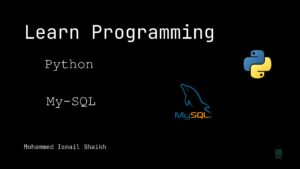
1. Introduction to Python
- What is Python?
- Installing Python and setting up a development environment (IDEs: Jupyter, VS Code, PyCharm)
- Running Python code (script vs. interactive mode)
- Python syntax and basic commands
2. Data Types and Variables
- Numeric data types: integers, floats
- Strings and string manipulation
- Boolean values
- Lists, tuples, and sets
- Dictionaries
- Type casting and checking types
3. Control Flow
- Conditional statements (
if,else,elif) - Loops:
forandwhile - Nested loops
break,continue, andpassstatements
4. Functions
- Defining functions
- Function arguments and parameters (positional, keyword, default)
- Return values
*argsand**kwargs- Lambda functions
- Scope (global vs local variables)
5. Input and Output
- Taking user input
- Printing output
- File I/O (reading from and writing to files)
6. Error and Exception Handling
- Common Python errors
- Using
try,except,finally, andelse - Raising exceptions
7. Data Structures
- Lists: operations, slicing, and methods
- Tuples: immutability and use cases
- Sets: uniqueness, set operations (union, intersection)
- Dictionaries: key-value pairs, common methods
- Comprehensions (list, set, and dictionary comprehensions)
8. Modules and Packages
- Importing built-in modules
- Creating and importing custom modules
- Installing external packages (using
pip) - Understanding and managing virtual environments
9. Object-Oriented Programming (OOP)
- Classes and objects
- Attributes and methods
- The
__init__method (constructor) - Inheritance
- Polymorphism
- Encapsulation
- Magic methods (e.g.,
__str__,__len__, etc.)
10. Working with Libraries
- Using libraries such as:
math(for mathematical operations)random(for generating random values)datetime(working with dates and times)osandsys(for file system and system operations)json(working with JSON data)collections(defaultdict, namedtuple, Counter, deque)
11. Data Science and Visualization (optional for advanced courses)
- Using
pandasfor data manipulation - Using
numpyfor numerical computations - Data visualization with
matplotlibandseaborn
12. Testing and Debugging
- Using
printstatements and logging - Introduction to debugging tools (e.g., pdb)
- Writing unit tests with
unittestorpytest
13. Working with APIs
- Making HTTP requests with
requests - Parsing and handling JSON
- Understanding REST APIs and interacting with them
14. File Handling
- Reading and writing text files
- Working with CSV, JSON, and Excel files
- File paths and directories
15. Regular Expressions (Regex)
- Introduction to regex
- Matching patterns in strings
- Using the
remodule
16. Concurrency and Parallelism (Advanced)
- Multithreading
- Multiprocessing
- Using async and await for asynchronous programming
17. Database Interaction
- Introduction to SQLite
- CRUD operations using Python
- Using
sqlite3orSQLAlchemyfor database interaction
18. Web Development (optional)
- Introduction to Flask or Django
- Building simple web applications
- Handling requests and responses
19. Version Control and Collaboration
- Introduction to Git
- Using Git for version control with Python projects
- Collaborating with GitHub
20. Best Practices
- Writing clean and readable code (PEP 8 standards)
- Code documentation
- Refactoring code
- Writing efficient and optimized code
21. Advanced Topics (optional)
- Decorators
- Generators and iterators
- Context managers (with
withstatement) - Metaprogramming and introspection
- Type hinting and annotations



